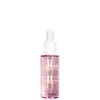What's inside
What's inside
 Key Ingredients
Key Ingredients

 Benefits
Benefits

 Concerns
Concerns

No concerns
 Ingredients Side-by-side
Ingredients Side-by-side

Vaccinium Vitis-Idaea Fruit Juice
Skin ConditioningWater
Skin ConditioningPropanediol
SolventButylene Glycol
HumectantGlycerin
HumectantPhenoxyethanol
PreservativeXanthan Gum
EmulsifyingHydroxyacetophenone
AntioxidantChondrus Crispus
MaskingSodium Gluconate
Skin ConditioningHydrolyzed Sodium Hyaluronate
Skin ConditioningEthylhexylglycerin
Skin ConditioningSodium Hyaluronate
HumectantSh-Polypeptide-121
Skin ConditioningPentylene Glycol
Skin ConditioningBiosaccharide Gum-1
HumectantSodium Hyaluronate Crosspolymer
HumectantPotassium Sorbate
PreservativeVaccinium Vitis-Idaea Fruit Juice, Water, Propanediol, Butylene Glycol, Glycerin, Phenoxyethanol, Xanthan Gum, Hydroxyacetophenone, Chondrus Crispus, Sodium Gluconate, Hydrolyzed Sodium Hyaluronate, Ethylhexylglycerin, Sodium Hyaluronate, Sh-Polypeptide-121, Pentylene Glycol, Biosaccharide Gum-1, Sodium Hyaluronate Crosspolymer, Potassium Sorbate
Water
Skin ConditioningCetearyl Alcohol
EmollientGlycerin
HumectantEthylhexyl Stearate
EmollientGlyceryl Stearate Se
EmulsifyingPentaerythrityl Distearate
EmulsifyingPhenoxyethanol
PreservativeSilica
AbrasiveCaffeine
Skin ConditioningSodium Stearoyl Glutamate
CleansingHelianthus Annuus Seed Oil
EmollientSodium Polyacrylate
AbsorbentCamellia Sinensis Leaf Extract
AntimicrobialPropylene Glycol
HumectantTitanium Dioxide
Cosmetic ColorantPolysorbate 20
EmulsifyingEthylhexylglycerin
Skin ConditioningCitric Acid
BufferingTocopheryl Acetate
AntioxidantSodium Hyaluronate
HumectantPrunus Armeniaca Fruit Extract
Skin ConditioningLupinus Albus Seed Extract
Skin ConditioningLecithin
EmollientRetinol
Skin ConditioningCaprylyl Glycol
EmollientPotassium Sorbate
PreservativeSodium Benzoate
MaskingAcetyl Hexapeptide-8
HumectantTocopherol
AntioxidantBHT
AntioxidantBHA
AntioxidantWater, Cetearyl Alcohol, Glycerin, Ethylhexyl Stearate, Glyceryl Stearate Se, Pentaerythrityl Distearate, Phenoxyethanol, Silica, Caffeine, Sodium Stearoyl Glutamate, Helianthus Annuus Seed Oil, Sodium Polyacrylate, Camellia Sinensis Leaf Extract, Propylene Glycol, Titanium Dioxide, Polysorbate 20, Ethylhexylglycerin, Citric Acid, Tocopheryl Acetate, Sodium Hyaluronate, Prunus Armeniaca Fruit Extract, Lupinus Albus Seed Extract, Lecithin, Retinol, Caprylyl Glycol, Potassium Sorbate, Sodium Benzoate, Acetyl Hexapeptide-8, Tocopherol, BHT, BHA
Ingredients Explained
These ingredients are found in both products.
Ingredients higher up in an ingredient list are typically present in a larger amount.
Ethylhexylglycerin (we can't pronounce this either) is commonly used as a preservative and skin softener. It is derived from glyceryl.
You might see Ethylhexylglycerin often paired with other preservatives such as phenoxyethanol. Ethylhexylglycerin has been found to increase the effectiveness of these other preservatives.
Glycerin is already naturally found in your skin. It helps moisturize and protect your skin.
A study from 2016 found glycerin to be more effective as a humectant than AHAs and hyaluronic acid.
As a humectant, it helps the skin stay hydrated by pulling moisture to your skin. The low molecular weight of glycerin allows it to pull moisture into the deeper layers of your skin.
Hydrated skin improves your skin barrier; Your skin barrier helps protect against irritants and bacteria.
Glycerin has also been found to have antimicrobial and antiviral properties. Due to these properties, glycerin is often used in wound and burn treatments.
In cosmetics, glycerin is usually derived from plants such as soybean or palm. However, it can also be sourced from animals, such as tallow or animal fat.
This ingredient is organic, colorless, odorless, and non-toxic.
Glycerin is the name for this ingredient in American English. British English uses Glycerol/Glycerine.
Learn more about GlycerinPhenoxyethanol is a preservative that has germicide, antimicrobial, and aromatic properties. Studies show that phenoxyethanol can prevent microbial growth. By itself, it has a scent that is similar to that of a rose.
It's often used in formulations along with Caprylyl Glycol to preserve the shelf life of products.
Potassium Sorbate is a preservative used to prevent yeast and mold in products. It is commonly found in both cosmetic and food products.
This ingredient comes from potassium salt derived from sorbic acid. Sorbic acid is a natural antibiotic and effective against fungus.
Both potassium sorbate and sorbic acid can be found in baked goods, cheeses, dried meats, dried fruit, ice cream, pickles, wine, yogurt, and more.
You'll often find this ingredient used with other preservatives.
Learn more about Potassium SorbateSodium Hyaluronate is hyaluronic acid's salt form. It is commonly derived from the sodium salt of hyaluronic acid.
Like hyaluronic acid, it is great at holding water and acts as a humectant. This makes it a great skin hydrating ingredient.
Sodium Hyaluronate is naturally occurring in our bodies and is mostly found in eye fluid and joints.
These are some other common types of Hyaluronic Acid:
Learn more about Sodium HyaluronateWater. It's the most common cosmetic ingredient of all. You'll usually see it at the top of ingredient lists, meaning that it makes up the largest part of the product.
So why is it so popular? Water most often acts as a solvent - this means that it helps dissolve other ingredients into the formulation.
You'll also recognize water as that liquid we all need to stay alive. If you see this, drink a glass of water. Stay hydrated!
Learn more about Water